Check out my custom vibration dampener
Wilson Blade 98 16×19 v7 vs. v8
A Detailed Comparison
We hope you love this article. Just so you know, TennisCompanion may collect a small share of sales from the links on this page to help keep this site running. Learn more.
In 2021, Wilson released the Wilson Blade 98 16×19 v8, which begs the question. Is it better than the v7, and should you upgrade?
In this guide, I’ll provide you with a detailed comparison between the seventh and eighth generations of the Wilson Blade to help you decide whether you should upgrade or purchase.
If you’d like to learn more about the latest model, check out my in-depth review and playtest of the Wilson Blade 98 16×19 v8.
| Popular Wilson Blade Models |
| Wilson Blade 98 v8 16×19 |
| Wilson Blade 98 v8 18×20 |
| Wilson Blade 100 L v8 |
| Wilson Blade 104 v8 |
| Wilson Blade SW102 Autograph |
Article Contents
Click below to jump to a section
Tap below to jump to a section
Video
Design & Paint
Specs & Tech
Strings & Tension
Performance
Summary
New to TennisCompanion?
Create a free account and explore my latest videos below
Video Comparison
If you’re curious to see first-hand how the Wilson Blade 98 16×19 v7 and v8 differ, be sure to check out my video below.
In it, review the differences between the two frames and showcase the performance of each racquet on the court. Here are timestamps for the video, which you can reference to jump to a specific section of interest.
- 0:29 – Intro
- 0:47 – Specs & Tech
- 1:47 – Strings & Tension
- 2:21 – Peformance
- 3:37 – Summary
This guide is a written companion to the video, covering much of the same material but providing extra detail. Keep scrolling to learn about how the seventh and eighth-generation Blades differ.
Design & Paint
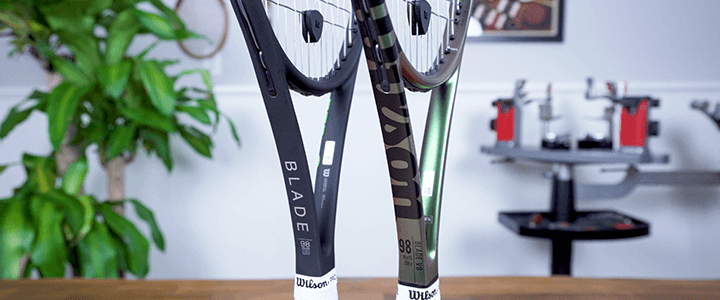
For the eighth generation of the Blade 98 16×19, Wilson introduces a fresh new paint job that completely breaks the mold of the simple matte black frames with a pop of color in the hoop racquet’s head.
The Wilson Blade 98 now offers a chameleon-style paint job that’s dynamic and shifts between green and copper depending on the light. I’m a huge fan of the change and happy to see Wilson changing things up.
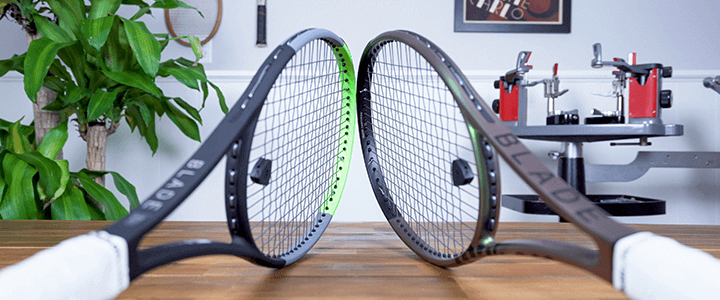
Of course, the Wilson Blade lineup has featured green highlights for the last few models, so it’s not surprising they kept that color as part of the cosmetic and makes it helpful in identifying the frame.
For context, here are the colors Wilson currently associates with each line of performance tennis racquets they offer:
- Green: Wilson Blade
- Black: Wilson Pro Staff
- Red: Wilson Clash
- Blue: Wilson Ultra
- Orange: Wilson Burn
Beyond the color, you’ll also notice the v8 offers a shinny finish vs. the matte finish of the v7. Unfortunately, the matte paint job isn’t the most durable, and many players have asked for improvements on this front.
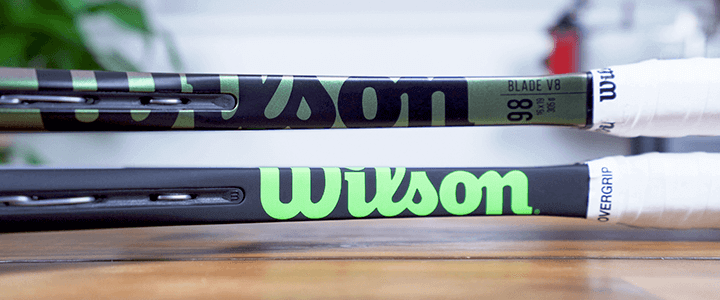
However, although the v8 doesn’t offer a matte finish, it’s not a thick glossy shell either, so don’t expect much improvement in durability.
I’d expect the peeling issue players have had with the matte finish to go away, but as far as nicks and scratches go, I’ve found the frame not to offer much of any improvement.
Specs & Tech
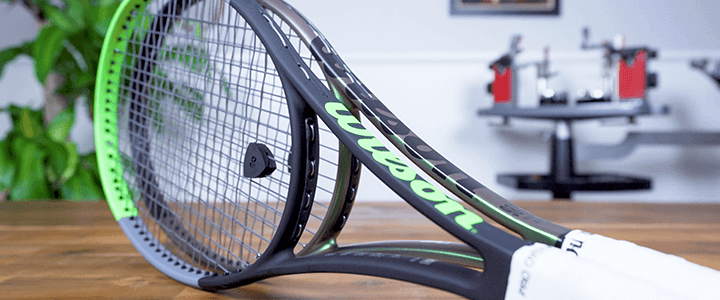
One of the first places to look when comparing tennis racquets is the specs, which provide a glimpse into how their performance will differ.
Helpful Tip
Keep in mind that specs only tell part of the story when it comes to performance and feel. A tennis racquet’s materials and construction also play a significant role, so it pays to hit with both frames to gain a concrete understanding of their differences.
Here’s a side-by-side comparison of the Wilson Blade 98 16×19 v7 and v8.
| Strung Specs | Blade 98 16×19 v7 | Blade 98 16×19 v8 |
| Length | 27in / 68.58cm | 27in / 69cm |
| Head Size | 98 in² / 632.26 cm² | 98 in² / 632.26 cm² |
| String Pattern | 16×19 | 16×19 |
| Weight | 11.4oz / 323g | 11.3oz / 320g |
| Balance | 4 pts HL (33 cm) | 5 pts HL (32.6 cm) |
| Swingweight | 328 | 317 |
| Stiffness | 62 | 61 |
| Beam | 21mm / 21mm / 21mm | 21mm / 21mm / 21mm |
As you can see, there’s a minor variation in weight, balance, swingweight, and stiffness, so from a performance standpoint, we’re talking about relatively minor changes that will have a subtle impact.
Furthermore, each frame maintains a braided graphite and basalt construction, and each uses Wilson’s FortyFive tech, previously called FeelFlex, in the v7 model.
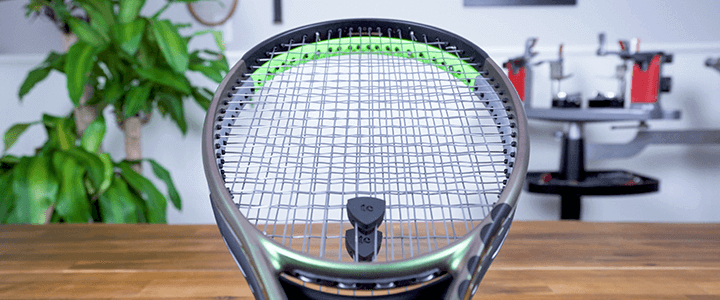
You’ll also find parallel drilling in both frames, red ergonomic butt caps, and a top grip taper design for each of the handles.
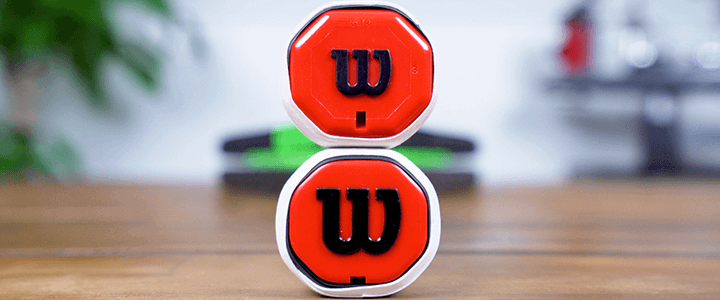
As a result, the only tech that’s new for the v8 model is Wilson’s DirectConnect handle, which fuses the butt cap with the handle’s carbon fiber for a bit of extra stability.

Despite similar specs, materials, and construction methods, there are some differences worth discussing, so we’ll get to those shortly.
Strings & Tension

The seven and eight-generation Wilson Blade have a recommended tension range of 50-60 lbs (22.68-27.2 kg).
For consistency when comparing the performance of each in a playtest, I strung both with 1.25 mm Luxilon ALU Power at 52 lbs or 23.6 kg.

If you’re not familiar with Luxlion ALU Power, it’s a lower-powered polyester that delivers excellent spin and durability with exceptional feel that I find compliments the Blade’s strengths.
Of course, many other strings work well with the Wilson Blade. Here are a few of my favorites that also complement this racquet:
However, if you’re looking for a bit of extra comfort and power, you might consider stringing with a polyester and multifilament or natural gut.
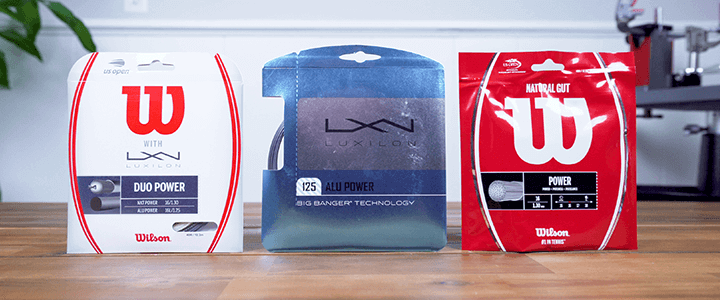
Combining two different strings, one for the mains and another for the crosses, is called hybrid stringing.
Performance

On the court, the Wilson Blade 98 16×19 v7 and v8 perform very similarly.
Both offer excellent feel, control, and comfort as highlights. However, hitting with them side by side, I noticed a few nuances in performance that are worth reviewing.

For starters, I found the v7 to offer better overall control and precision. Of course, not by a longshot, but for me, it’s a result of the frame’s slightly greater stability, which also translated to added touch and was my preferred frame up at the net.
At times, I did feel the v8 offered slightly better maneuverability, but the difference was very subtle and not a significant point of differentiation.
Surprisingly, the most noteworthy difference for me was comfort, where I found the v8 to deliver an overall more forgiving response.
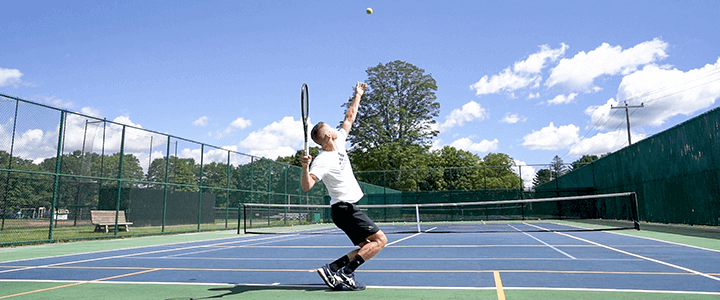
The added comfort was easy to notice hitting serves where I preferred the v8, but it was also apparent on groundstrokes where I found it to offer a slightly better connection with the ball and a small bit of extra power to go along with it.

On groundstrokes, it was a mixed bag. I prefer the v8 hitting topspin but found the v7 to deliver a more consistent and solid performance on slice.

Finally, on returns, I also give the v7 a slight edge where its added weight and stability benefit the frame.
Summary
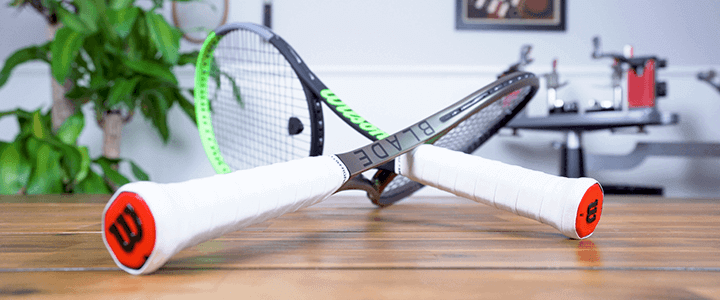
Although the 8th generation doesn’t present a significant leap forward, it’s certainly not a step back and outshines the 7th generation in a few areas. Here’s a quick recap of my preferences for each racquet.
| Attribute | Blade v8 16×18 v7 | Blade v8 16×18 v8 |
| Groundstrokes | X | |
| Volleys | X | |
| Serves | X | |
| Returns | X | |
| Power | X | |
| Control | X | |
| Spin | X | |
| Slice | X | |
| Touch/Feel | X | |
| Maneuverability | X | |
| Stability | X | |
| Comfort | X |
Although there are nuances in performance, if I were considering an upgrade, I’d likely save myself the money and stick with my old frames because the performance gap isn’t enough to justify the change.
At the same time, if your old v7 frames are beaten up and need replacing and anything about my preferences for the latest model resonates with you, then I think you’ll be happy moving to the eighth generation.
Furthermore, if I were buying a Blade for the first time, I’d opt for the v8 because I found its performance to better align with my game.
Plus, it will likely be easier to get matching replacements over the next few years, and I prefer the new paint job.
| Popular Wilson Blade Models |
| Wilson Blade 98 v8 16×19 |
| Wilson Blade 98 v8 18×20 |
| Wilson Blade 100 L v8 |
| Wilson Blade 104 v8 |
| Wilson Blade SW102 Autograph |
Wrapping Up
 The Wilson Blade 98 16×19 v7 and v8 are excellent frames, and the Blade remains on my list of the best overall.
The Wilson Blade 98 16×19 v7 and v8 are excellent frames, and the Blade remains on my list of the best overall.
Unfortunately, when manufacturers update tennis racquets, they don’t always end up with a winning formula. However, I’ve found the eighth generation of the Blade to live up to the name, so it’s well worth considering for intermediate to advanced players.
Are you considering upgrading or purchasing a new Wilson Blade? If so, what are your thoughts? We’d love to hear in the comments below.
Play Better Tennis
Improve your game alongside our community of tennis players
Why join?
Discussion Boards
Join the conversation with other members of the community.
5 Point Friday
Read our weekly recap of the 5 most interesting things we dig up in tennis.



Leave a Reply
Want to join the discussion?Feel free to contribute!